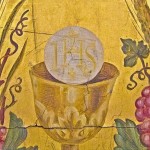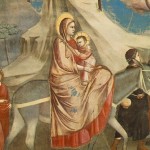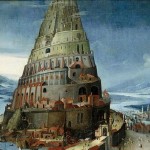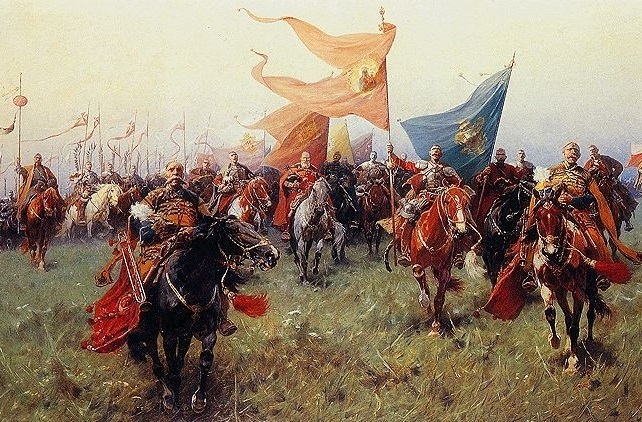
I ran across the oldest recorded text in Poland’s history today. The hymn in question is not in Latin, but rather in colloquial Polish. So much for medievals being Latin fetishists.
[Reading Suggestion: scroll down to the bottom of this post and hit play on the YouTube video, then start reading from the top.]
I couldn’t figure out why it popped up in my feed until I read the following:
Happy 1,050th birthday, Poland! On this day in 966, the Polish ruler converted to Christianity, transforming Poland into a recognized European state.
Poland had existed prior to this in some form, of course. As the Roman Empire collapsed in the early centuries AD, Germanic and Slavic tribes moved in and began to take over lands in central and eastern Europe. Already by the sixth century, western Slavic people began to settle throughout what is today Poland.
These western Slavs broke off into various tribes, such as the Vistulans, who settled in Krakow, and the Polans, who settled around Gniezno and Poznan. Poland grew out of the Polans. The Polan rulers were known as the Piasts.
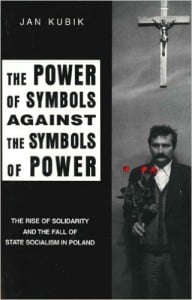
The 1000th anniversary of Poland’s baptism was the occasion of an epic battle between the communists and the Church for legitimation. The church with Cardinal Wyszynski and then Bishop Wojtyla won hands down. When the Church wasn’t allowed to tour the Black Madonna painting all around the country, it toured the frame of the painting. Hundreds of thousands, if not millions, showed up to see the frame. It was the ultimate surrealist happening. The whole episode is recounted in great detail in The Power of Symbols Against the Symbols of Power: The Rise of Solidarity and the Fall of State Socialism in Poland:
The icon was forcefully detained…. But the pilgrimage went on. The icon’s empty frame, sometimes adorned with flowers, sometimes with a burning candle or a Bible inside, continued its tour and visited four southern and two eastern dioceses. The perils and power of religion in Communist Poland came to be symbolized by the vacant frame. According to the bishops, “The difficulties and harassment encountered [by the traveling icon] did not diminish the respect shown for the Mother of God. On the contrary, they inspired even greater love for the Divine Traveler. People, with broken hearts, looked at the empty frame, but gathered in ever growing numbers.”
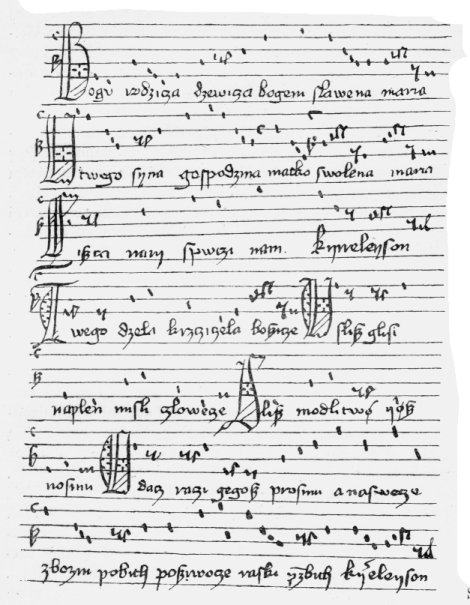
Back to the text in question. It is known as “Bogurodzica,” that is, Theotokos (Mother of God). Here are the lyrics from the collection Selected Masterpieces of Polish Poetry.
First in Polish:
Bogurodzica dziewica, Bogiem sławiena Maryja,
U twego syna Gospodzina Matko zwolena, Maryja!
Zyszczy nam, spuści nam.
Kyrie elison!Twego dziela Krzciciela, bożycze,
Usłysz głosy, napełń myśli człowiecze.
Słysz modlitwę, jąż nosimy,
A dać raczy, jegoż prosimy:
A na świecie zbożny pobyt,
Po żywocie rajski przebyt.
Kyrie elison!
Now in English:
Virgin, Mother of God, God-famed Mary!
Ask Thy Son, our Lord, God-named Mary,
To have mercy upon us and hand it over to us!
Kyrie eleison!Son of God, for Thy Baptist’s sake,
Hear the voices, fulfill the pleas we make!
Listen to the prayer we say,
For what we ask, give us today:
Life on earth free of vice;
After life: paradise!
Kyrie eleison!
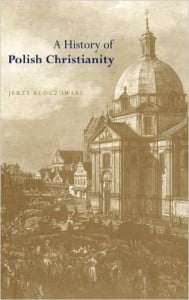 “Bogurodzica” was composed sometime between the 10th and 13th centuries. The first print record of it appeared in the 15th century (see picture above).
“Bogurodzica” was composed sometime between the 10th and 13th centuries. The first print record of it appeared in the 15th century (see picture above).
The eminent historian of Norman Davies also reminds us in his now classic history of Poland (its translation is used in Polish schools), God’s Playground: A History of Poland, Vol. 1: The Origins to 1795, that the hymn was sung at Piast dynasty coronations, and during the Battle of Gruenwald in 1410 (Remember that one? Hitler did.).
Contemporary Poland is probably the most Catholic nation in the world. Upwards of 90% of Poles are Catholics, but this is merely an accident of history. Poland was about 65-70% Catholic before the Germans and Soviets redrew its boundaries after WW2. Weekly Mass attendance is somewhere between 50% and 60%. The most complete account of the complicated twists and turns of Polish Christianity can be found in Kloczowski’s A History of Polish Christianity. You can find out more about early modern Poland by reading this book as well. The Polish Commonwealth was the largest state in Europe since it included modern day Poland, Ukraine, and Lithuania. Even more significantly, it was the first properly pluralistic nation-state, multi-ethnic and multi-religious, long before the United States usurped that title for itself.
Finally, to round everything out, here’s a stunning rendition of “Bogurodzica” by Agnieszka Budzinska-Bennett from the CD Sacer Nidus:
Poland’s history is much more complicated than the country being an appendage of the Papal States. If you want the insider knowledge about the country’s religious history then take a look at my Catholiclandia series.
Please also consider making a donation to this blog through the donation button on the upper right side of its homepage.
Stay in touch! Like Cosmos the in Lost on Facebook:



